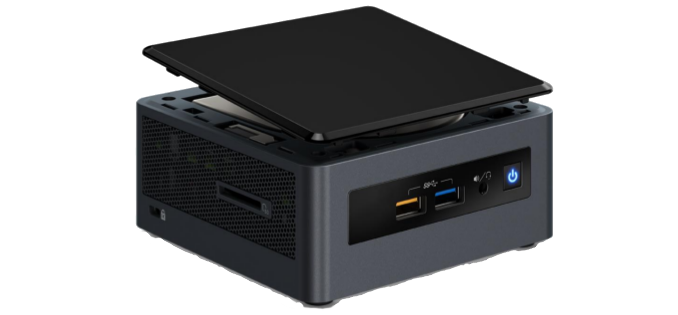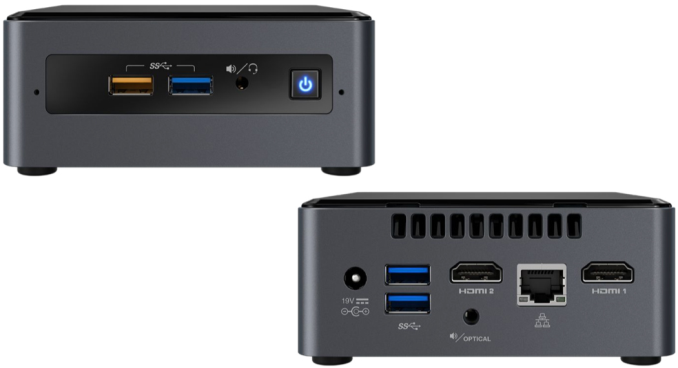Intel’s Crimson Canyon NUCs with Cannon Lake CPU & Radeon dGPU Available for Pre-Order
by Anton Shilov on August 8, 2018 11:00 AM EST
SimplyNUC, a retailer specializing on SFF PCs, has started to take pre-orders for Intel’s NUC8i3CYSM and NUC8i3CYSN ultra-compact form-factor PCs (codenamed "Crimson Canyon"), which are based on Intel’s Cannon Lake processors. The new systems are outfitted with AMD’s discrete Radeon 540 graphics processor and are the first Intel NUCs to feature a fully discrete GPU on a separate chip. The retailer belongs to Intel’s Platinum Technology Providers, so the pre-sales are all but official confirmation of the products and their specificaitons.
The Intel NUC8i3CY-series UCFF PCs come in traditional 4.6-inch × 4.4-inch form-factor and are based on Intel’s dual-core Core i3-8121U processor accompanied by AMD’s Radeon 540 dGPU (codenamed Lexa, based on Polaris architecture, featuring 512 SPs) with 2 GB of GDDR5 memory. The systems come with 4 GB or 8 GB of LPDDR4-2666 memory, all of which is soldered down. By default, the NUC8i3CY-series are equipped with 1 TB SATA hard drive, but there is also one M.2-2280 slot for a SATA or a PCIe SSD.
It is noteworthy that Simply NUC's documents covering Intel's NUC8i3CYSM and NUC8i3CYSN UCFF PCs do not explicitly state the processor the systems use is the Core i3-8121U, which belongs to the Cannon Lake family and is made using Intel’s 10 nm process technology. Still, the papers say that the chip in question belongs to Intel’s 8th Gen of Core i3 U-series products, they disclose its core count, base and boost frequencies. Meanwhile, the only dual-core Core i3 8000U processor clocked at 2.2 – 3.2 GHz is the Core i3-8121U. It also lacks iGPU, which is why the NUCi3CY-series PCs need a dGPU. By contrast, its 14-nm brethren — the Core i3-8130U — features 2.2 – 3.4 GHz frequencies and has an iGPU.
When it comes to performance, Cannon Lake has its perks, such as AVX-512 support, though they may not be that obvious in the SFF space as they are in the HPC/HEDT space. Evidently, AMD’s Radeon 540 should also be faster than Intel’s UHD 630 Graphics in games, but keep in mind that when it comes to media playback Intel’s contemporary iGPUs have certain advantages over AMD’s Polaris (e.g., VP9 10-bit decode, support for sophisticated copyright protection methods that require Intel’s SGX, etc.).
Back to the systems. Both NUCs are outfitted with Intel’s Wireless-AC 9560 CNVi 802.11ac Wi-Fi + Bluetooth 5 solution that supports up to 1.73 Gbps throughput over 160 MHz channels. In addition, the systems have one GbE, two HDMI 2.0a outputs, four USB 3.0 Type-A ports (one supporting charging), an SD card reader, a TRRS audio connector for headsets, and a digital audio connector for 7.1-channel sound systems.
Time to talk about availability. SimplyNUC, a retailer that specializes on custom-built Intel’s NUC UCFF PCs, currently offers to pre-order the NUC8i3CYSN with 4 GB of memory for $529 as well as the NUC8i3CYSM with 8 GB of memory for $574. The more advanced machine is expected to ship in mid-September, whereas the cheaper model will hit the market in October.
| Intel Crimson Canyon NUC PCs | |||
| NUC8i3CYSN | NUC8i3CYSM | ||
| CPU | Intel Core i3-8121U 2C/4T 2.2 - 3.2 GHz 4 MB cache 15 W TDP |
||
| Graphics | AMD Radeon 540 GPU 512 stream processors 32 texture units 16 ROPs 2 GB GDDR5 memory |
||
| PCH | Integrated into CPU | ||
| Memory | 4 GB LPDDR4-2666 | 8 GB LPDDR4-2666 | |
| Storage | 2.5-inch | 1 TB HDD pre-installed | |
| M.2 | M.2-2280 slot supporting SSDs and Intel Optane Memory caching SSDs | ||
| Wi-Fi/BT | Intel Wireless-AC 9560 802.11ac Wi-Fi + BT 5 |
||
| Ethernet | Intel Gigabit Ethernet controller (i219-V) | ||
| Display Outputs | 2 × HDMI 2.0a | ||
| Audio | 3.5 mm TRRS audio jack 7.1 channel audio output via HDMI Optical output |
||
| IR | Consumer Infrared (CIR) sensor on the front panel | ||
| USB | 4 USB 3.0 Type-A (5 Gbps), one with charging | ||
| Other I/O | SDXC card reader with UHS-I support | ||
| Dimensions | 117 × 112 × 52 mm | 4.6 × 4.4 × 2.04 inch | ||
| PSU | External, 90 W | ||
| OS | Pre-installed Microsoft Windows 10 Home x64 | ||
Related Reading:
- First 10nm Cannon Lake Laptop Spotted Online: Lenovo Ideapad 330 for $449
- Intel Officially Launches Bean Canyon NUCs with Coffee Lake-U Processors
- The Intel NUC8i7HVK (Hades Canyon) Review: Kaby Lake-G Benchmarked
- Intel NUC8i7HVK (Hades Canyon) Gaming Performance - A Second Look
- Intel NUC6CAYH (Arches Canyon) Apollo Lake UCFF PC Review
Sources: Liliputing, SimplyNUC (1, 2)















25 Comments
View All Comments
mode_13h - Wednesday, August 8, 2018 - link
> It also lacks iGPU, which is why the NUCi3CY-series PCs need a dGPU.Heh, buried in the 3rd paragraph.
Wingartz - Wednesday, August 8, 2018 - link
Noob question, the yellow USB port is....??SeanFL - Wednesday, August 8, 2018 - link
If it's similar to my NUC, a constantly powered USB for charging a phone for example when the NUC is off.HStewart - Wednesday, August 8, 2018 - link
My think pad for work also has this functionality - oddly it been power on as desktop machine for the last 4 or so years - rarely use that functionallywr3zzz - Wednesday, August 8, 2018 - link
Yellow denotes always-on power. It's a USB 3.0 port that can charge devices even if the the PC is off.sprockkets - Wednesday, August 8, 2018 - link
Provides more charging current.HStewart - Wednesday, August 8, 2018 - link
I can see a good use as a developer for this product. The i3-8121U does support AVX 512 and this could likely be a cheaper alternate to start development on the product. Also it support Optane Memory - which to effective used - requires development support.abufrejoval - Wednesday, August 8, 2018 - link
I wonder just how many wafers of these broken 10nm CPUs they don't want to throw away just because the iGPU doesn't work and the CPU doesn't live up to 10nm expectation?I didn't know Intel to be 'green' that way and I'm not even sure if its not greener to turn them back into sand...
Caveat emptor, these are crippled chips and too power hungry to be useful as mobiles (noticed the 90 Watts power brick?).
I'm pretty sure a Kaby or Skylake with the Iris 550 and eDRAM will perform at a similar level of performance with less energy consumption. Why? Because I have one and tested it extensively.
I have an Intel Core i5-6267U based notebook and an A10-7850K Kaveri APU with 512 GCN graphic cores, not exactly the same generation, but I expect at similar levels for performance as the Radeon 540 here.
The Intel has DDR3-1600, because the BIOS won't accept higher speeds, the AMD has DDR3-2400, because I wanted to give it the best possible bandwidth to ensure it could actually use all 512 GPU cores for maximum benefit (as recommended on this site).
The Skylake notebook and the AMD Kaveri are very evenly matched on all graphics tests, they are not too far away on pure CPU loads, even if the Intel gets a bit ahead on single and multi workloads.
These are only the Geekbench values, I did vastly more extensive testing.
AMD: http://browser.geekbench.com/v4/cpu/8991367
Intel: http://browser.geekbench.com/v4/cpu/8803309
OpenCL AMD: http://browser.geekbench.com/v4/compute/1304546
OpenCL Intel: http://browser.geekbench.com/v4/compute/2545546
The difference: Intel draws 30 Watts at the wall socket tops, AMD can go up to 150 Watts, generally above 100Watts once you mix Prime95 and Furmark, because it has to drop back from its 4GHz peak clock. And the Intel only needs 3GHz and the rather ordinary RAM to be faster on CPU, while the 64MB eDRAM level the field against DDR3-2400 and 512 AMD GPU cores.
I got the Kaveri, because I wanted to explore HSA and VMs with virtualized passthrough GPUs: It was supposed to be the first bit of hardware able to do both.
But the software support for both never happened...
Spunjji - Thursday, August 9, 2018 - link
The Radeon 540 here will significantly outperform that Kaveri. Kaveri is crippled by bandwidth starvation and sharing a TDP never really helped it, either; added to that it was a couple of manufacturing nodes behind by the time it hit the market. Your comparison isn't at all valid.TL;DR: Iris 550 doesn't have squat on a 512 core Polaris dGPU. It's about half as fast in its best case performance. Even if we assume the GPU here is hobbled by thermal throttling, it's still going to be noticeably quicker than Intel's best.
lmcd - Saturday, August 11, 2018 - link
Iris 550? Iris 580 doesn't have anything on a dGPU with real VRAM. A 550 wouldn't even be close.Now, if he's benching on Linux then maybe (wasn't HSA basically useless on Windows?).